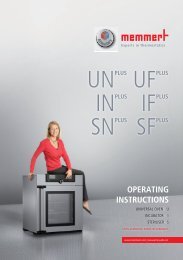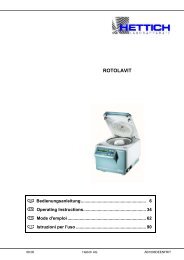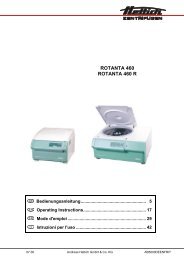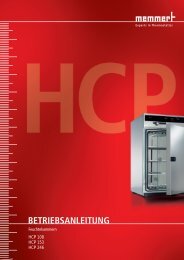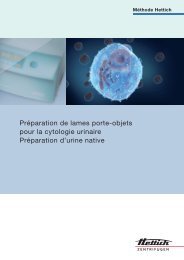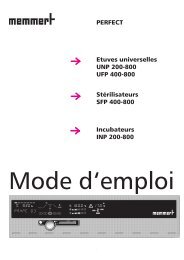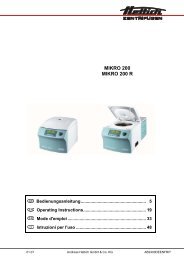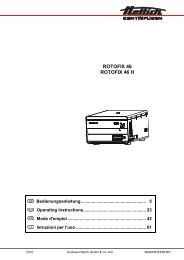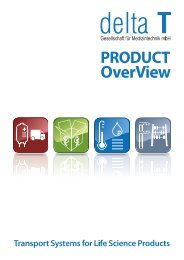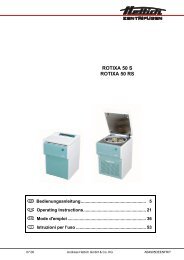MAN-Rotina380-e - Hettich AG, CH
MAN-Rotina380-e - Hettich AG, CH
MAN-Rotina380-e - Hettich AG, CH
Create successful ePaper yourself
Turn your PDF publications into a flip-book with our unique Google optimized e-Paper software.
EN<br />
29 Centrifugation of materials with higher density<br />
The rotors are designed to centrifuge substances up to a maximum mean homogenous density of 1.2 kg/dm 3 when<br />
rotating at the stated speed.<br />
Denser substances must be centrifuged at lower speed.<br />
The permissible speed can be calculated using the following formula:<br />
Reduced speed (nred)<br />
=<br />
1.2<br />
Greater density<br />
x Rated speed<br />
e.g.: RPM 4000, density 1.6 kg/dm 3<br />
1.2<br />
nred = x 4000 = 3464 RPM<br />
1.6<br />
If in doubt you should obtain clarification from the manufacturer.<br />
30 Rotor Identification<br />
After every start of a centrifugation run the rotor utilised is identified.<br />
After changing a rotor, the engine switches off and the rotorcode (rotor), the maximum rotor speed of the rotor<br />
(Nmax) and the preset centrifuging radius (R) of the rotor being used are displayed, e.g. rotor 4 Nmax= 4500<br />
R=184 mm.<br />
• Press the STOP / OPEN key to open the lid, or press the START key to start the centrifugation run. For centrifuges<br />
with refrigeration, precooling of the rotor can also be started by pressing the key.<br />
If, following a rotor change, the maximum speed of the rotor is less than the set speed, the speed is limited to<br />
the maximum speed of the rotor. In this case, the program place number is displayed in parentheses ().<br />
31 Emergency release<br />
During a power failure the lid cannot be unlocked by motor. An emergency release has to be executed by hand.<br />
For emergency release disconnect the centrifuge from the mains.<br />
Open the lid only during rotor standstill.<br />
See figure on page 2.<br />
• Switch off the mains switch (switch position "0").<br />
• Look through the window in the lid to be sure that the rotor has come to a standstill.<br />
• Insert the hexagonal wrench key into the bore hole (Fig. 1, A) and carefully rotate by half a turn in clockwise<br />
direction until the lid can be opened.<br />
• Pull the hexagon socket head wrench out of the drilling again.<br />
• After turning the centrifuge on again, press the button STOP / OPEN so that the motor-driven lid locking once<br />
again assumes the normal position (opened).<br />
32 Maintenance and servicing<br />
Pull the mains plug before cleaning.<br />
Before any other cleaning or decontamination process other than that recommended by the manufacturer is<br />
applied, the user has to check with the manufacturer that the planned process does not damage the device.<br />
• Cleaning agents and disinfectants which lie in the pH range 5 – 8 are to be utilised. Alkaline cleaning agents with<br />
a pH value > 8 are to be avoided.<br />
• In order to prevent appearances of corrosion through cleaning agents or disinfectants, the application guide from<br />
the manufacturer of the cleaning agent or disinfectant are absolutely to be heeded.<br />
32.1 Centrifuge<br />
• Clean the centrifuge housing and the centrifuging chamber regularly, using soap or a mild detergent and a damp<br />
cloth if required. For one thing, this services purposes of hygiene, and it also prevents corrosion through<br />
adhering impurities.<br />
• In the event of condensation water formation, dry the centrifugal chamber by wiping out with an absorbent cloth.<br />
• If infectious materials penetrates into the centrifugal chamber this is to be disinfected immediately. For surface<br />
disinfection we recommend Bacillol® manufactured by Bode Chemie in Hamburg or Biocidal ZF TM from the<br />
company WAK-Chemie Medical GmbH in Steinbach.<br />
• Lightly rub the rubber seal of the centrifuge chamber with talcum powder or a rubber care product after each<br />
cleaning.<br />
37/105



